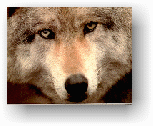 What are
Wolves ?
What are
Wolves ?Questions and Answers about Wolves
 What are
Wolves ?
What are
Wolves ?
Wolves are large, powerful, graceful wild canines which were once common throughout North America, Europe, and Asia, but now live mostly in remote wilderness.
There are two species of wolves in North America:
The smaller red wolf (Canis rufus) was once found throughout the southeastern United States. By the late 1960's, their numbers had dwindled to small populations in Texas and Louisiana and they could not find enough mates of their own species, they started interbreeding with coyotes.
The larger gray wolf (Canis lupus) can actually range in color from almost pure black to almost completely white, and often is golden brown, but the individual guard hairs are banded light-dark-light-dark. This is called agouti banding, and is found in a number of wild species.
There are a number of different races or subspecies of gray wolf living in various terrain, from the frozen tundra of the Arctic wolves to the dense forests where wolves live in Minnesota, and even in the mountainous Southwest, where the Mexican wolf (Canis lupus baileyi) once lived.
 Are Wolves
Endangered ?
Are Wolves
Endangered ?
In the United States, both red and gray wolves are listed as an endangered species, except in Minnesota where the gray wolf is listed as threatened, and in Alaska where the gray wolf is not currently listed at all.
Of all the subspecies of gray wolves, the Mexican wolf is the most endangered. Unlike many animals whose decline was due mostly to habitat loss from human settlement, the Mexican wolf was the target of a deliberate trapping and poisoning campaign carried out in the early part of the 20th century by the federal government, which considered them pests. This has been the fate of many subspecies of gray wolves and has resulted in their status as endangered in many areas.
Fortunately, today many people understand how beneficial wolves are, weeding out weak and diseased prey animals, which helps to balance the ecosystem.
The U.S. Fish and Wildlife Service has a captive breeding program for the Mexican wolf, and several facilities in Mexico are helping also. Sadly, even after years of captive breeding, there are only a few over 60 Mexican wolves in the entire United States, all in captivity. There is a plan to reintroduce them in New Mexico, currently undergoing review for an Environmental Impact Statement.
 Other wolves in the United States are doing better. There
are between 4,000 and 7,000 wolves in Alaska. Unfortunately, there has been a
recent wolf reduction program in progress there, involving the killing of 50 to
75 percent of the wolf population in a localized area. Although the wolf
population as a whole in Alaska will not be affected by the program, many
biologists and others strongly oppose what they feel is a politically motivated,
completely unjustified program.
Other wolves in the United States are doing better. There
are between 4,000 and 7,000 wolves in Alaska. Unfortunately, there has been a
recent wolf reduction program in progress there, involving the killing of 50 to
75 percent of the wolf population in a localized area. Although the wolf
population as a whole in Alaska will not be affected by the program, many
biologists and others strongly oppose what they feel is a politically motivated,
completely unjustified program.
There are about 1500 to 1900 wolves in Minnesota, mostly in the northeast. About 30 to 50 live in Wisconsin, a dozen or so on the upper peninsula of Michigan along with an additional 12 on Isle Royale (also in Michigan), and about 100 in Montana. Isolated reports of a few individuals have been made in Idaho, Washington, North Dakota, and a few other states.
Currently, there is a reintroduction program in progress to reinstate wolves into the Yellowstone National Park area, where they are the only animals lacking in what will soon be a complete ecosystem.
How Big are Wolves ?
Most adult male wolves weigh between 80 to 110 pounds, with females usually weighing 10 to 20 pounds less. They may stand up to 32 inches high at the shoulder, and are often 6 to 6 1/2 feet from nose to tail. They usually weigh 15 to 20 pounds more in the winter than in the summer due to a heavier fur coat, among other things.
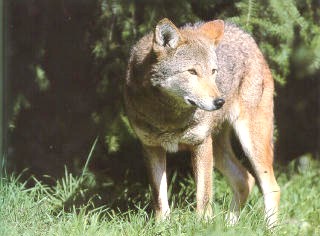 How Do Wolves Stay Warm Outside All the
Time ?
How Do Wolves Stay Warm Outside All the
Time ?
Wolves have a double layer of fur. A wooly underfur grows very thick in the fall and winter and keeps the wolf warm, while an outer layer of guard hairs repels snow and water, and keeps the underfur dry so it can trap air as an insulator. When a storm arrives, a wolf will often lie down behind a fallen tree or brush pile (using it as a wind break), curl up and tuck its nose under its bushy tail. In this way, it can easily survive temperatures will below zero. During the spring, the thick underfur sheds so the wolf can survive the heat.
Do Wolves Live Alone ?
Wolves are social animals, living together in family groups called packs. In order to live together peacefully, they have an elaborate system of rank order. Just as an Army private has to obey sergeants, and both of them follow orders from a general, low-ranking wolves must defer or submit to higher-ranking ones. This keeps order within the pack and minimizes fighting.
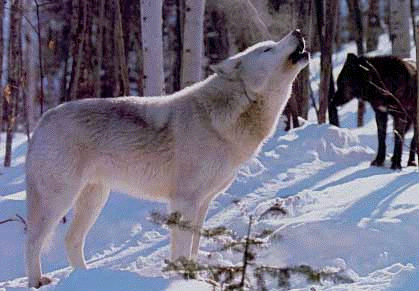 Why Do Wolves
Howl ?
Why Do Wolves
Howl ?
Wolves howl for a variety of reasons. A pack will howl to advertise their presence and mark their territory (they will also use urine to scent-mark their territory). Pack members can recognize each other's howls, so when they are separated, they can locate each other. A group howl will often lead to a rally, where pack members gather around, nuzzle, and greet a high-ranking wolf -- most often the alpha male or female. Sometimes wolves just howl for reasons we don't fully understand.
What Does Rank Order Mean?
Each pack has a top male, called the alpha male, who submits to no one and to whom all the other males defer. Likewise, there is an alpha female, to whom all other females must submit. Next in rank to the alphas are the beta male and beta female. For each gender, every wolf has a rank or place in line where they must submit to anyone higher than they are, but can bully or dominate the wolves lower in rank.
At the bottom there is an omega male and omega female. These wolves have no one under them and may be harassed to the point where they disperse, or leave the pack. If they are very lucky and find a mate, and if there is enough territory available for them, they might be able to start a new pack of their own.
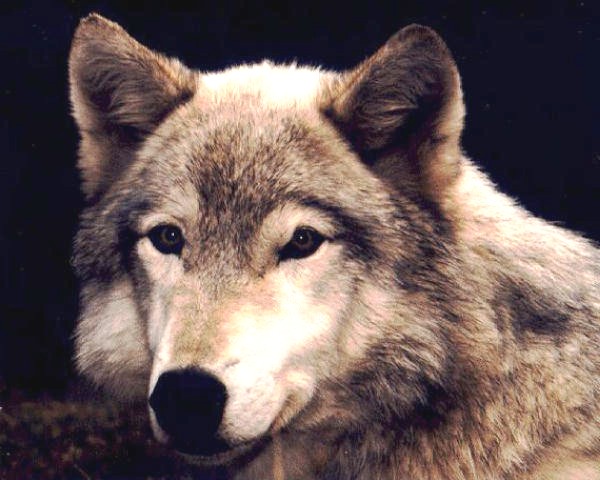 Within the pack, wolves will constantly demonstrate their
rank. When two wolves in the pack meet, the higher-ranking one will show
aggression and confidence by raising its tail, putting its ears forward, lifting
its lips in a snarl, and making itself look as big and threatening as possible.
The hackles, the fur along the top of its back, will go up
automatically when a wolf is threatening a lower-ranking one.
Within the pack, wolves will constantly demonstrate their
rank. When two wolves in the pack meet, the higher-ranking one will show
aggression and confidence by raising its tail, putting its ears forward, lifting
its lips in a snarl, and making itself look as big and threatening as possible.
The hackles, the fur along the top of its back, will go up
automatically when a wolf is threatening a lower-ranking one.
The subordinate, or lower-ranking wolf, tries to make itself look small and non-threatening. Its tail will be tucked under its belly, ears laid back flat, and it will roll over and submit to the higher-ranking wolf, licking its muzzle and "letting it know that it's boss."
In almost all cases, this ritual substitutes for actual fighting. If wolves often fought and hurt each other, they might be too injured to be able to hunt and survive.
 What Do Wolves Eat?
What Do Wolves Eat?
Wolves are carnivores, which means they eat meat. They hunt mostly large hoofed animals, called ungulates (such as deer, elk, moose, bison, and caribou). Because most of the prey animals that wolves hunt are much bigger than the wolves themselves, it is only by hunting in groups and cooperating that wolves can catch enough food to survive.
Even working together, it is difficult for wolves to catch their prey. Healthy deer can easily outrun wolves, while large animals like moose or bison often stand their ground until the wolves give up.
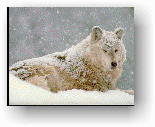 Typically, wolves do not waste a lot of time going after obviously healthy prey.
Instead, they are skilled at noticing weaknesses, testing animals by getting
them to run and seeing which ones appear old or sick.
Typically, wolves do not waste a lot of time going after obviously healthy prey.
Instead, they are skilled at noticing weaknesses, testing animals by getting
them to run and seeing which ones appear old or sick.
Some studies by biologists have shown that when wolves hunt deer, an average of 84 to 87 deer out of 100 escape. The ones that are caught are usually either old, sick, or very young, not fit ones in the prime of life.
After catching and killing their food, wolves sometimes eat up to 20 percent of their body weight in meat. For a typical 100 pound adult male wolf, that is like eating 80 quarter-pound hamburgers in one sitting!
Other times food is scarce and wolves can go several weeks without eating at all. On average, adult wolves need about 5 pounds of meat per day in the winter, and about half that in the summer. Pups and juveniles need much more food for their body weight than adults.
When pups are young, the adults eat a lot at the kill site, then bring the food back inside their stomachs to the pups. When the pups greet the adults by licking and biting at the corners of their mouths, the big wolves regurgitate (or throw up) some of the partly digested food, which the pups eagerly gobble up.
 When Are Pups Born?
When Are Pups Born?
Usually in April. Wolves have one breeding season each year, from mid- January to the end of February. Sixty-three days after mating, the mother wolf will have an average of four to six pups, born in an underground den she has dug.
The pups weigh only about one pound each at birth, and cannot see, hear, smell, or keep warm by themselves. The mother feeds them her milk, and other pack members bring food to the den for her to eat.
The pups' eyes open after about 10 days. Around three weeks after birth, the pups begin to explore outside the den. Sometimes the mother carries the pups to another den to guard them from harm. When the pups are a little older, they are left at rendezvous sites, usually with an adult "baby-sitter," while the rest of the pack hunts for food. By fall, the pups are about 80 percent of their adult size, and are able to travel with the pack as they hunt throughout the winter.
Are Wolves Dangerous To People?
No. Wolves are very shy animals, and are afraid of people, avoiding us whenever possible. Even though people are expanding into the few remaining areas where wolves are found in large numbers, there has *never* been a documented case of a healthy wild wolf deliberately attacking a person in North America.
Some people try to keep wolves, or wolf-dog mixes known as "wolf hybrids," as pets. Many think that if they raise a wolf pup with love and treat it like a dog, it will grow up to be a loyal pet and fierce watchdog.
The problem is that they see the many similarities between wolves and dogs, and ignore the vital differences. Although dogs originally developed from wolves, it occurred by selective breeding for thousands of generations that actually altered the genetic makeup of the animal. This changed the animal's innate or "built-in" behavior to make it suitable for living with people in a home. The behavior of wolves, and of many wolf hybrids, which enables them to survive in the wild, makes them unsuitable as a pet.
 Dishonest people often sell northern-breed dog mixes as
"wolf-hybrids" when they actually have little or no wolf in them.
Because these dogs may be wonderful pets, many people refuse to believe that
wolf hybrids need special handling. Sometimes these misguided people later get a
real hybrid and cannot safely handle it.
Dishonest people often sell northern-breed dog mixes as
"wolf-hybrids" when they actually have little or no wolf in them.
Because these dogs may be wonderful pets, many people refuse to believe that
wolf hybrids need special handling. Sometimes these misguided people later get a
real hybrid and cannot safely handle it.
Often, when people do try to treat them as if they were dogs, the animals end up in a situation where their normal behavior results in an attack, sometimes fatally injuring someone. The animals are almost invariably killed, and the image of an entire endangered species suffers.
Why Do Some People Dislike Wolves?
Many people fear and hate wolves. Ranchers worry that wolves will kill their livestock. In areas like Yellowstone National Park, where people killed off the existing wolf population and where a reintroduction of gray wolves is beginning, private groups have set up funds to compensate ranchers for any proven stock losses to wolves.
In Minnesota, where wolves live in close proximity to livestock already, fewer than one percent of farms report any losses at all. With proper livestock management techniques, including the use of livestock guarding dogs, wolves can be reintroduced without economic hardship to farmers and ranchers.
Unfortunately, people still believe old stories and fables about wolves. Tales like "Little Red Riding Hood" and contemporary werewolf horror films paint the wolf in a negative manner and only increase fear and hatred for those who cannot separate the fictional image from the real animal.
Introduction
[ What is A Wolf ? ] [ Myth And Legend of The Wolf ] [ Physiology of The Wolf ] [ Communication And Behavior of The Wolf ]
[ Family and Social Structure of The Wolf ] [ Hunting And Selection of Prey ] [ The Wolf Today ]
Poems
[ The Lone She-Wolf ] [ Fight of The Midnight Wolf ] [ The Spirit of The Wolf ] [ The Spirituality of Silent Wolf ]
[ The Lady of The Wolves ] [ The Wolf ]
Miscellaneous
[ Did You Know ? ] [ The Language of Wolves ] [ Wolves - Worldwide ] [ Questions And Answers About Wolves ]
Guest Book
[ Special Dedication ] [ Sign My Guest Book / Feedback ] [ View My Guest Book ] [ e-mail Me ]
Best view in IE5. Pentium II. True color (24 bits). Resolution 640 x 480